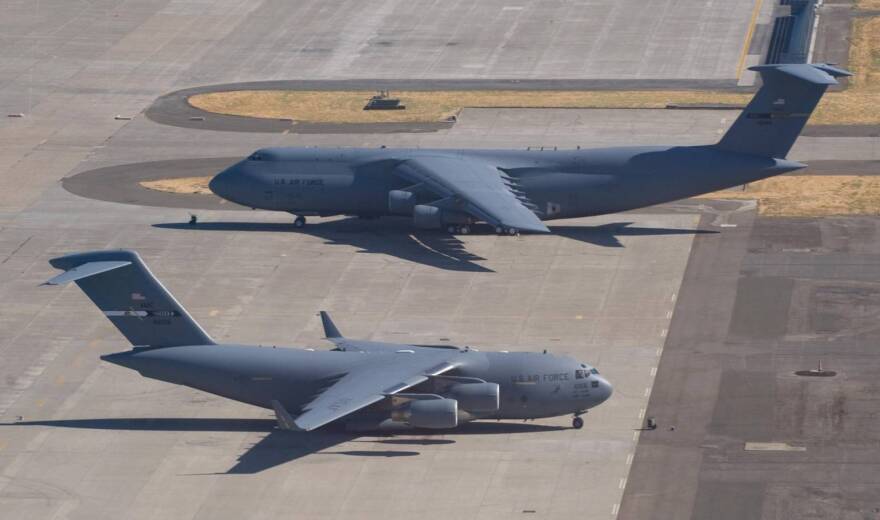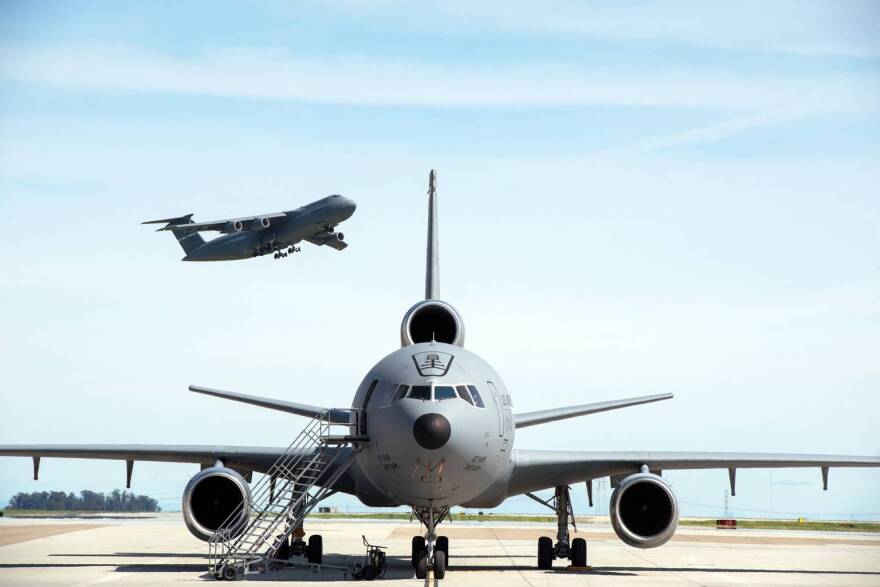The Trump administration is looking to build an immigration detention facility at Travis Air Force Base in Fairfield, California, and pushing to speed up a review process, according to internal government communications obtained by KQED.
The proposed installation is part of an aggressive effort to expand immigration detention nationally, and specifically to use property owned by the U.S. Department of Defense in service of President Trump’s stated goal of deporting 1 million people in his first year in office.
In the early April emails, federal officials discussed efforts to evaluate several military installations, including Travis Air Force Base, for Homeland Security’s immigration detention and removal operations — and tee them up for approval by Defense Secretary Pete Hegseth.
The emails show significant coordination among Department of Defense and Homeland Security officials to expedite the plans. The emails do not describe the scope or design of the proposed detention compound at Travis Air Force Base, nor how many people it would be expected to hold.
A spokesperson for U.S. Immigration and Customs Enforcement did not respond directly to questions about Travis Air Force Base, but he did affirm that ICE is actively working to expand detention capacity.
“While we cannot confirm individual pre-decisional conversations, we can confirm that ICE is exploring all options in California to meet its current and future detention requirements, which include new detention facilities and possible support from partner agencies,” a written statement from the agency said.

Officials at Travis Air Force Base declined to comment, and the Department of Defense did not respond to KQED’s request for comment by press time.
Homeland Security officials have been considering at least 10 military bases around the country for immigration detention, NPR has reported. A February Homeland Security memo obtained by NPR described a plan to use Fort Bliss, near El Paso, TX, as a model for other facilities, with up to 1,000 people initially detained there, eventually expanding to as many as 10,000.
The revelation that Travis is on the list of military facilities came as a shock to East Bay Rep. John Garamendi, a Democrat and senior member of the House Armed Services Committee whose district includes the Fairfield base.
“Travis Air Force Base is absolutely inappropriate for an immigration detention facility,” Garamendi told KQED. “Travis has a critical national security role of providing worldwide transportation services for personnel and material around the world. An immigration facility would significantly hamper the national security work that Travis is responsible for.”
Earlier this year, Garamendi and other members of Congress raised strenuous opposition when military aircraft from the base — C-17 planes typically meant for troops or cargo — were used for deportation flights to remove immigrants from the country.
“Just in terms of the cost factor, to say nothing of the readiness, every time you take a military aircraft and you use it for purposes that are not directly related to the national security work, that degrades the ability of the military to do what it’s supposed to do,” he said.
Meanwhile, a plan to use the U.S. naval base at Guantanamo Bay, Cuba, to detain as many as 30,000 immigrants appears to have been scaled back drastically in the face of obstacles, including public outcry over the $40 million pricetag to lock up a couple of hundred men during its first month of operation.
ICE is currently holding nearly 48,000 immigrants in detention facilities nationwide. Last year, ICE’s detention capacity was 41,500 beds. However, last month, Congress added $430,000 to ICE’s current-year detention budget, allowing the agency to increase capacity to 54,500 beds.
The number of detention beds is one factor limiting the Trump administration’s ability to increase deportations. ICE would also need to increase staffing and other resources, beyond last year’s $3.4 billion detention budget, which advocates say was already a historic high. The administration is looking to the Republican-controlled Congress to vastly expand the Homeland Security budget, and The New York Times has reported that ICE has already solicited proposals from contractors worth as much as $45 billion for the next two years.

Previous administrations have used military bases to temporarily house arriving refugees and have deployed soldiers to provide logistical support to the U.S. Border Patrol. But the plan to use Travis and other military facilities for ICE detention represents a more substantial move toward militarizing immigration enforcement.
Trump’s “border czar,” Tom Homan, has called the Department of Defense a “force multiplier” for his deportation plans.
However, Jehan Laner, a senior staff attorney at the Immigrant Legal Resource Center in San Francisco, argues that using military bases for ICE detention violates the Posse Comitatus Act, a 19th-century law that limits the use of military personnel to enforce domestic policies within the U.S.
“Our country is kind of turning towards authoritarianism when you have the military starting to do civil law enforcement,” she said. “It becomes a very scary prospect.”





